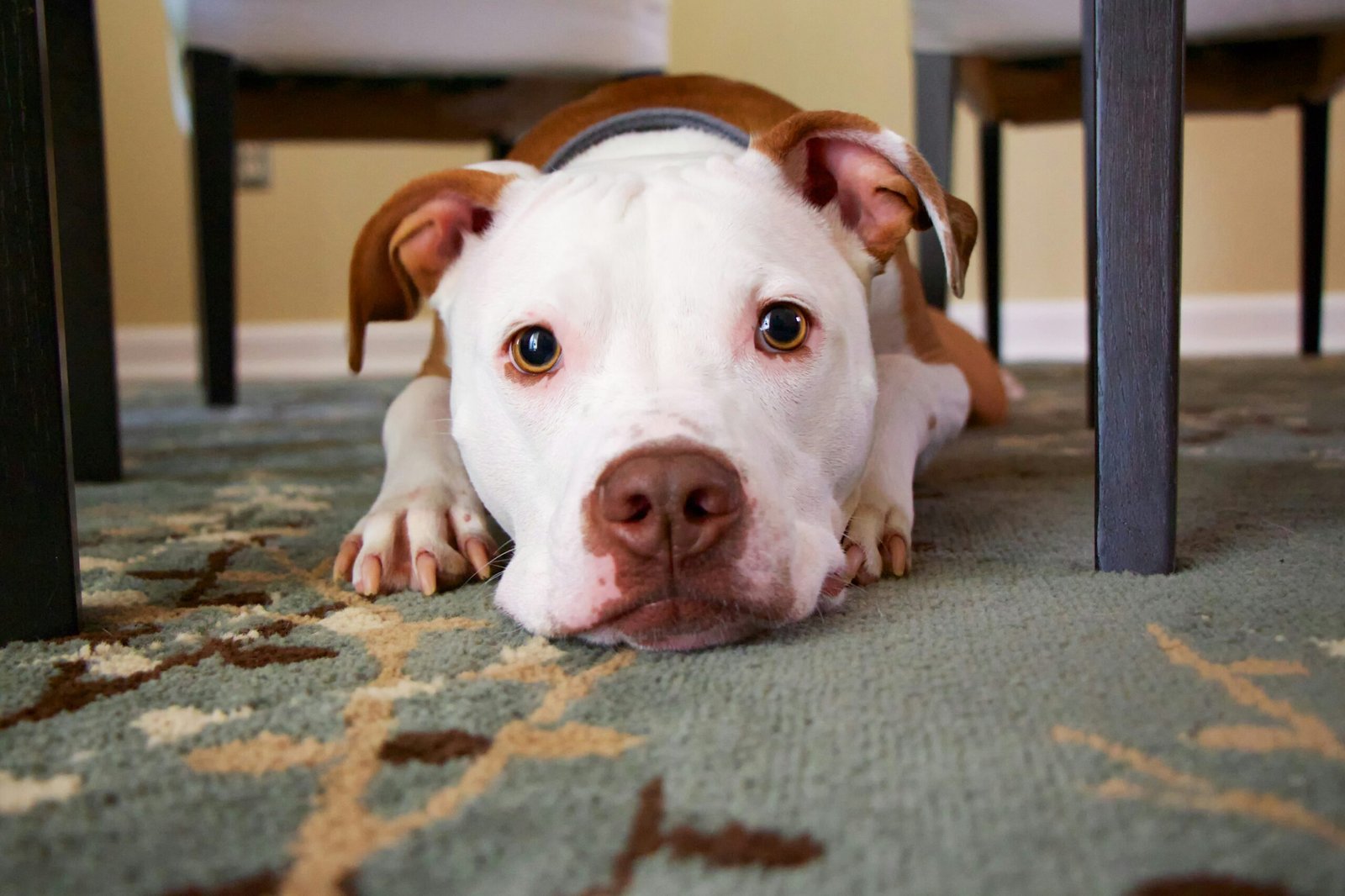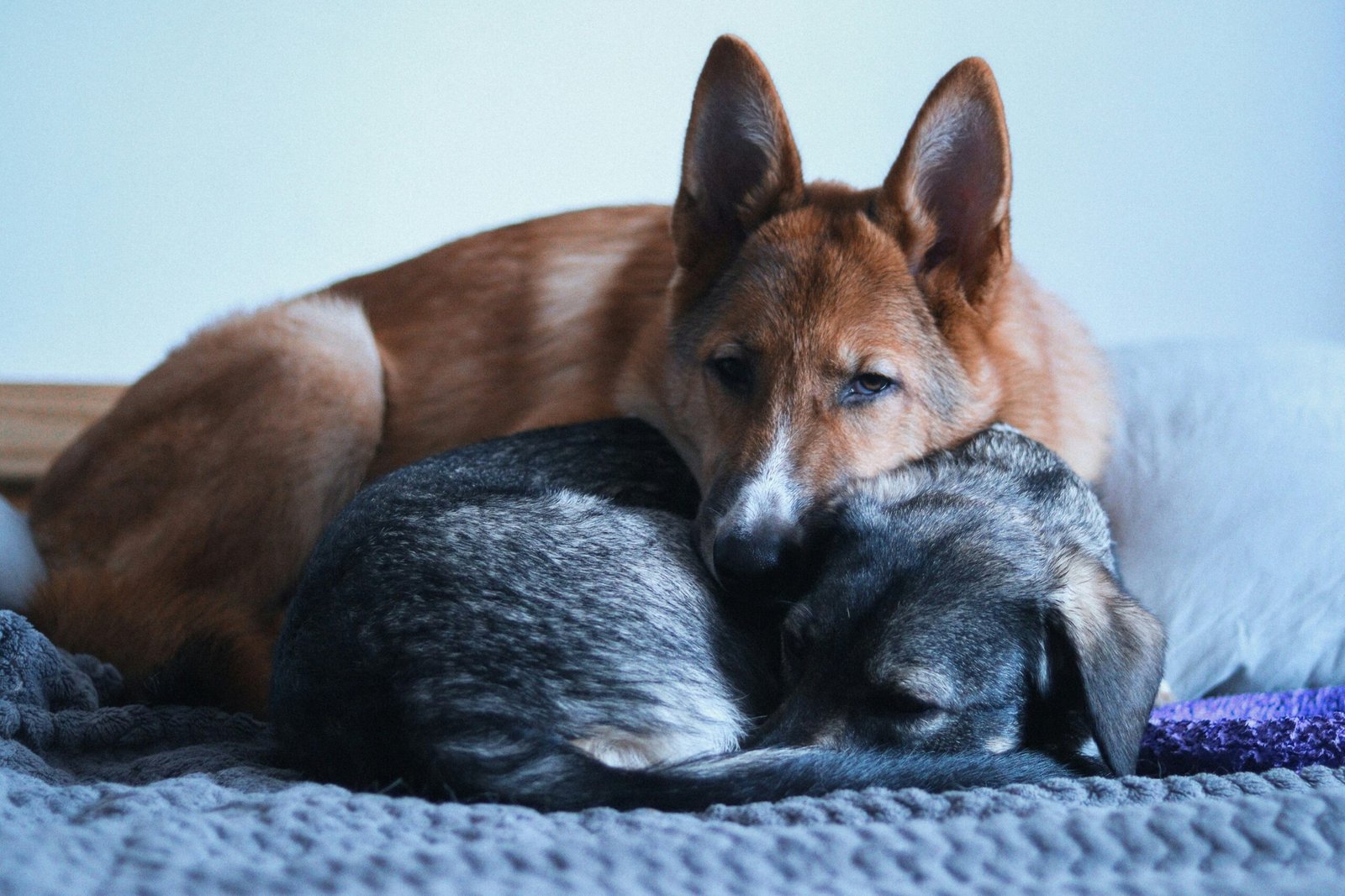Introduction to Dog Lying Positions
Understanding the various lying positions of dogs is crucial for any pet owner who wishes to foster a deeper bond with their canine companion. Dogs possess a unique ability to communicate their feelings and state of well-being through body language, and their lying positions serve as important indicators of their emotional and physical conditions. By observing how a dog chooses to rest, owners can gain valuable insights into their pet’s comfort level, stress factors, and overall health.
Dogs adopt different lying positions based on numerous variables, such as their environment, mood, and physiological state. For instance, a dog that lies on its side with paws extended often indicates contentment and relaxation. This position signifies trust in the surroundings, a clear indicator that the dog feels safe. Conversely, if a dog curls into a tight ball, it may be a sign of insecurity or discomfort, prompting owners to be attentive to their pet’s needs.
Understanding these positions can also prove pivotal in assessing your dog’s health. Abnormal lying postures or frequent changes in sleeping habits could suggest underlying medical issues. For example, a dog that suddenly prefers to lie in a stiff or awkward position may be experiencing pain or discomfort that warrants a veterinary evaluation.
So, becoming attuned to your dog’s lying positions not only deepens your understanding of their emotional landscape but also enables you to respond to their needs more effectively. By paying attention to such behaviors, pet owners can ensure a healthier, happier life for their four-legged family members. Now, Let’s dive into the fascinating world of why dogs choose to sleep the way that they do.

The ‘Loaf’ or ‘Sphinx’ Position
The ‘loaf’ or ‘sphinx’ position is a common resting posture seen in dogs, characterized by their legs tucked comfortably underneath their bodies while the head remains elevated. This position allows dogs to rest while still being alert, demonstrating a natural readiness to react to their surroundings. Dogs often adopt this stance when they are in a secure environment and feel relaxed yet prepared to engage with their owners or respond to stimuli in their environment. It is an interesting position that highlights the balance dogs maintain between rest and vigilance.
This resting position indicates that the dog is comfortable and at ease. The loaf posture allows dogs to conserve body heat, making it particularly favorable in cooler environments. You may notice your dog switching to this position when they are laying on a hard surface or a cool floor, which might be their way of seeking warmth while maintaining a mindset of alertness. As a result, the loaf position serves both practical and behavioral purposes.
However, it is essential to consider any avoidance of this position by a dog, as it may signal underlying joint or abdominal discomfort. If a dog consistently avoids the loaf position or shows signs of discomfort, such as whining or reluctance to lie down, it may be necessary to consult with a veterinarian. Additionally, observing how long the dog can maintain this position without seeming restless can provide insights into their overall well-being. Understanding the nuances of the loaf or sphinx position can help owners make more informed decisions about their dog’s health and comfort.

Side Sleeping
The side sleeping position is one of the most telling postures in canine body language. When a dog lays flat on its side, it signifies a state of profound relaxation and comfort. This position is often adopted when a dog feels secure in its environment and with the people or animals around it. Trust is a crucial factor here; a dog will rarely sleep in such a vulnerable position unless it is entirely at ease. In addition, this posture indicates that the dog is likely in a deep sleep cycle, which is vital for its overall health and well-being.
Observing a dog in the side sleeping position can provide insights into its emotional state. For instance, if a dog frequently chooses to sleep on its side in the presence of its owner or family members, it suggests a strong bond between the dog and its human companions. This level of comfort is an essential aspect of a healthy and trusting relationship. Furthermore, dogs that embrace this sleeping position may also enjoy a higher quality of rest, which is beneficial for their physical and mental health.
Conversely, a dog that tends to avoid side sleeping may exhibit signs of anxiety or discomfort in its surroundings. This could be a signal that the dog does not fully trust its environment or may feel threatened in some way. A lack of trust can stem from various factors, including past trauma, insufficient socialization, or negative experiences. It is crucial for pet owners to pay attention to these behaviors and create a safe and comforting environment to encourage their dog to relax fully, including adopting side sleeping as a natural behavior. Addressing any underlying issues can lead to a more harmonious relationship and a happier, healthier dog.

The ‘Superman’ Position
One of the more amusing and recognizable sleeping positions in dogs is the ‘Superman’ position, where a dog lies flat on its stomach with its legs stretched out behind it. This posture is often observed in puppies, who tend to adopt it as they settle down for a nap or rest. The ‘Superman’ position appears to provide a sense of security and comfort, allowing the puppy to spring into action at a moment’s notice. This is particularly relevant in breeds known for their playful and energetic nature, as it enables quick movement if playtime calls.
When a puppy lies in the ‘Superman’ position, it may also indicate that it feels safe in its environment. The extension of the legs behind them can signal a relaxed state, demonstrating that the puppy is comfortable enough to expose its vulnerable belly. This position can reflect a dog’s playful personality, as they often oscillate between energetic bursts and deep, cozy slumbers.
As dogs age, however, the adoption of the ‘Superman’ position may decrease. Older dogs may find it increasingly uncomfortable due to joint-related issues or arthritis. Consequently, you might observe them opting for more supportive sleeping arrangements, such as curling up or lying on one side. While the decrease in this position does not necessarily indicate a problem, it can be a signal that the dog prefers to avoid stress on its joints. Pet owners should be attentive to such changes. Incorporating supportive bedding can help older dogs enhance their comfort and encourage healthy sleeping habits. Regular veterinary check-ups are advisable, particularly if signs of discomfort arise, ensuring that both young and senior dogs maintain a good quality of life.

Curled-Up Ball Position
The curled-up ball position is a common and frequently observed resting posture in dogs. In this position, dogs typically tuck their legs under their bodies and bring their tails to touch their noses, creating a compact, circular shape. This posture is not only endearing but also serves significant practical purposes for canine comfort and well-being.
One of the primary reasons dogs adopt the curled-up ball position is for heat conservation. When a dog curls up tightly, it minimizes the surface area exposed to the cooler air, thus helping them retain body heat. This behavior is particularly common during colder months or in chilly environments where dogs seek warmth. Additionally, this position may indicate that the dog feels secure and safe in its surroundings, as curling up can be a protective instinct inherited from their wild ancestors who sought to shield themselves from potential threats while resting.
However, if a dog consistently remains curled up for extended periods, it may raise concerns regarding its health and well-being. Excessive curling may suggest discomfort, pain, or anxiety. For instance, dogs suffering from joint issues or other physical ailments might choose this position instinctively to ease their discomfort, as the curled-up posture can provide some relief from pain. Moreover, if a dog appears withdrawn and frequently adopts this position, it could indicate underlying stress, depression, or other emotional issues that require attention.
It is essential for pet owners to monitor their dog’s resting positions and overall behavior. While curling up can be a normal behavior, any persistence in this posture, especially when combined with other signs of distress or discomfort, should prompt a consultation with a veterinarian. Ensuring that your dog has a comfortable and secure environment is key to fostering their overall health and happiness.

Belly Up, Having Too Much Fun
The belly up position, where a dog lies on its back with its belly exposed, is one of the most endearing and revealing postures that signifies comfort and trust. When a dog displays this position, it is often a clear indication that they feel safe and secure in their environment, allowing them to show vulnerability in a space where they believe they won’t be harmed. This behavior can reflect the strong bond between the dog and its owner, showcasing the trust the animal has developed through positive interactions.
There are several benefits to this position. Firstly, lying belly up can aid in regulating a dog’s body temperature, as the exposed skin can dissipate heat more effectively. This posture also encourages relaxation, which can be essential for a dog’s overall mental well-being. Feeling secure enough to expose their abdomen can also promote healthy pacing in a dog’s life, allowing them to recharge effectively.
However, it is important to consider the potential health implications associated with this position, particularly for dogs that may be predisposed to hip or back issues. In some cases, dogs with these health concerns might have difficulty transitioning to or maintaining this position due to discomfort or pain. Owners should observe their pets closely; if a dog frequently rolls onto its back and appears to be in distress or struggles to rise again, this may warrant a discussion with a veterinarian to rule out any underlying health problems.
In conclusion, while the belly up position is typically a sign of a content and trusting dog, it is essential for pet owners to remain vigilant regarding their dog’s health. Observing how often and comfortably a dog adopts this position can provide valuable insights into their emotional state and physical well-being.

Factors Influencing Lying Positions
Understanding the factors influencing a dog’s preferred lying positions can provide valuable insights into their behavior and well-being. Several elements come into play when dogs select their restful postures, including breed and size, age, and health conditions.
First, the dog’s breed and size significantly affect their lying positions. For instance, larger dog breeds, such as Great Danes or Mastiffs, typically require more space and may favor sprawling positions to accommodate their size. In contrast, smaller breeds like Chihuahuas or Dachshunds might opt for curled or tucked positions, which offer a sense of security due to their compact stature. Additionally, certain breeds are predisposed to specific behaviors; for example, herding dogs may lie in watchful postures, ready for action, reflecting their natural instincts.
Age is another critical factor influencing a dog’s comfort and lying positions. Puppies often exhibit playful and loose behaviors, frequently changing their positions as they explore their environment. Conversely, senior dogs may display more rigid lying positions due to discomfort or arthritis, indicating their physical limitations. This alteration in behavior highlights the importance of breed-specific care and the need for appropriate resting areas, which can significantly enhance a senior dog’s quality of life.
Health conditions also play a pivotal role in determining a dog’s lying preferences. Dogs suffering from pain or illness may instinctively adopt positions that alleviate discomfort. For example, a dog with hip dysplasia may prefer positions that alleviate joint stress, such as lying on their side with legs extended. Recognizing these changes in lying positions can assist owners in identifying potential health issues, guiding them to seek veterinary consultation where necessary. Pay attention to these factors, as understanding your dog’s needs will foster a deeper bond and ensure overall well-being.
Harmful Positions and Warning Signs
Understanding your dog’s lying positions is crucial, as certain postures can indicate discomfort or underlying health issues. One common position that may signal distress is prolonged tucking of the legs beneath the body. In this stance, the dog may appear compact and small, using this posture as a means of self-protection or to minimize pain. If you notice your dog consistently lying in this position, it is advisable to consult a veterinarian to assess for possible injuries or stress factors.
Another behavior to monitor is a dog’s reluctance to lie on one side. This may suggest that a dog is experiencing discomfort in specific areas of its body. For instance, if your dog typically favors one side for resting, it may be indicative of pain or joint issues, such as dysplasia or arthritis. Being attentive to your dog’s comfort can help you identify if there’s an urgent need for medical intervention.
It is important to maintain a watchful eye on your dog’s lying habits. Alterations in their usual positions may be red flags indicating potential health issues or stress. By remaining aware of these warning signs, you can take proactive measures to ensure your dog’s comfort and seek the necessary veterinary attention when required. Always prioritize your dog’s health by fostering a safe and nurturing environment.

Recommendations for Your Pup
Understanding your dog’s lying positions can provide invaluable insights into their general well-being and emotional state. To foster an environment conducive to relaxation, dog owners should meticulously observe their pets’ preferred resting configurations. This practice not only enhances your connection with your dog but also allows you to recognize behaviors that may indicate discomfort or stress.
One fundamental recommendation is to prioritize the creation of a comfortable and safe environment for your dog. Ensure that the resting area is quiet, free of disturbances, and adequately sized for their breed. Establishing a designated space for your dog to relax will enable them to feel secure and at ease. If your dog frequently changes positions, it may be an indication that their current bedding doesn’t offer sufficient support.
Investing in high-quality supportive bedding can significantly impact your dog’s health and comfort. Orthopedic dog beds are particularly beneficial for older dogs or those that experience joint issues, as they provide cushioning and support. Assess your dog’s sleeping habits and preferences—different breeds may exhibit varying tendencies such as curling up or sprawling out. Aligning your dog’s bedding with their natural resting positions will promote better sleep quality and overall well-being.
Furthermore, owners should remain attentive to any deviations from their dog’s usual lying positions. If a dog that typically rests comfortably begins to exhibit signs of discomfort, such as frequent changes in position or reluctance to lie down, it may be time to consult a veterinarian. Regular veterinary check-ups are essential to address any underlying health concerns that may be manifesting through changes in lying behavior.
By implementing these recommendations and paying close attention to your dog’s resting positions, owners can better understand their canine companions, ensuring a healthier and more comfortable life for their pets.
Conclusion
Understanding your dog’s lying positions is an essential aspect of canine care, offering valuable insights into their emotional state, health, and comfort. Through this exploration, we have identified several common lying positions and their meanings. For instance, when a dog is lying on its side with legs extended, it typically indicates trust and relaxation. Conversely, a dog curled up tightly may be feeling vulnerable or cold, highlighting the importance of ensuring a comfortable environment for your pet.
Recognizing these positions enables dog owners to become better interpreters of their pets’ behaviors and needs. Each position can serve as a communication tool that reflects both the physical and emotional health of the dog. For example, a dog that frequently shifts positions or exhibits signs of restlessness may require immediate attention, suggesting discomfort, anxiety, or potential health issues. Therefore, staying observant of these changes is crucial.
Furthermore, promoting a safe and cozy resting area for your pet can enhance their overall well-being. Providing quality bedding, appropriate ambient temperature, and a stress-free environment will encourage your dog to feel secure and relaxed, ultimately reflecting in their lying posture. By being proactive and attentive, dog owners can significantly contribute to their pet’s comfort and health.
In light of this information, it is evident that understanding your dog’s lying positions is not merely a matter of curiosity but a critical component of responsible pet ownership. As always check with your veterinarian if you are noticing any signs of pain or discomfort, they are there to help your dog live a healthy, happy life. By remaining alert to the signals expressed through their lying behaviors, owners can foster a deeper bond with their dogs while ensuring they lead happy and healthy lives.






